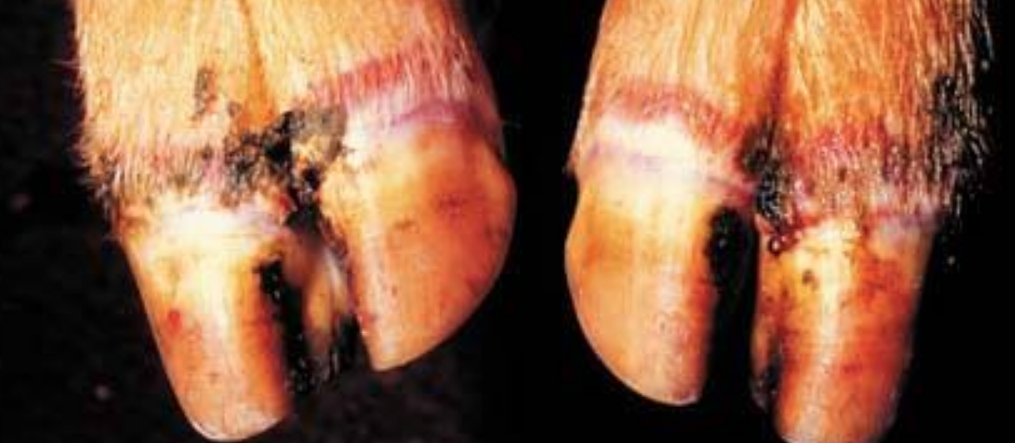Causes
This condition affects sows and boars of all ages. A number of separate conditions are grouped under this heading. All begin with some form of defect or penetration of the wall of the hoof or its bearing surface (sole and heel) which provides a point of entry for secondary bacterial invasion. Penetrations include erosions of sole, heel and toe, split or crack in the wall (sand crack) and separation of the wall from the sole at the white line. Infection spreads in the hoof in three possible ways: a deep necrotic ulcer may develop involving the laminae (the sensitive weight bearing living area) and coronary band (the hairless skin where the hoof joins the toe); necrotic (infected) tracks may reach the coronary band and form ulcers; or infection may penetrate deeply and involve the deep digital flexor tendon, or bones of the toes or the joints.
When abscesses burst at the coronet (coronary band), the condition is known as ‘bush foot’. Abrasive and chemical effects of newly-laid concrete contribute to the production of hoof defects, Wet, unhygienic conditions and poor bedding also contribute to what is often a herd problem. Bacteria such as Fusobacterium necrophorum, Arcanobacterium pyogenes and spirochaetes such as Treponema pedis may infect the lesions. Septicaemia and bacteraemia can occur and secondary abscesses may occur elsewhere, e.g. in brain, spine and liver.
Transmission
The physical conditions which underlie this condition are not themselves transmissible, but pigs exposed to them are at high risk of developing foot lesions in the same way as their predecessors in the accommodation. The infectious component of the condition depends upon the organisms to which the damaged foot is exposed, and some of the bacteria responsible may be present in the environment of the pig’s foot, having been shed by other affected pigs. It is possible for some of the bacteria in this complex to be transferred from farm to farm in pigs or on boots, tools and in transport.
Clinical signs
The most obvious clinical sign is lameness, pigs tend to walk on tip-toe, with ‘paddling’ or ‘goose stepping’ gait, and are reluctant to rise and move and may sit. The lameness may prevent the loading of animals for slaughter, prevent service in boars and sows and result in increased mortality amongst sucking piglets. Lateral claws, especially those of the hind feet, are most commonly affected. The affected claw is warm, painful and the primary lesion is usually apparent. Severe pain occurs when abscesses develop at the coronary band and the leg is often held off the ground. The heel and coronary band become swollen and blue-black in colour. Cellulitis may cause swelling in the limb and reach the carpus or the hock. Fever may be present if septicaemia or secondary abscessation have occurred. Bone and joint involvement may be seen as enlargement of the nearest joint.

An overgrown claw highlighting defects in the weight baring surface where infection can enter
Lameness or reluctance to rise usually draws attention to the existence of the condition. Once lameness has been identified, detailed inspection usually confirms that the foot is affected. If movement of the shoulder, hip, elbow, knee, carpus (wrist) or hock in the unanaesthetised pig does not cause pain and there is no enlargement or heat in these joints, then the lameness is in the foot.
The foot concerned should be cleaned with soap and water and examined. Cracked walls, ulcers at the coronary band, erosions of the sole and separation of the horn at the white line may all be seen. It may be necessary to expose lesions under overgrown horn by paring using a hoof knife. The absence of lesions in the other feet should be confirmed. Where a pig is particularly valuable, an x-ray examination can be performed or ultrasound examination carried out. This may require general anaesthesia or local anaesthesia of the lower limb by the veterinary surgeon. Swabs may be taken from sinuses to identify the bacteria present.
Treatment and prevention
Trimming a septic hoof lesion to expose the seat of the problem, poulticing, and bandaging can result in recovery, but may not be economical. The surface of exposed, cleaned lesions may be sprayed with antibiotic, e.g. tetracycline or dusted with an antibiotic wound powder. The animal may be given a course of antimicrobial such as tetracycline or ampicillin by injection.
Control depends upon improving hygiene and management, especially floor quality. Concrete flooring should be made using aggregate with rounded edges and re-surfaced if the aggregate has been exposed. If having slats, then they should be in good condition, have pencil edges and be at least 100 mm wide.
You can also run your pigs through foot baths containing 5-10% formalin 2-3 times a week where problems have been experienced with infection. Ensure that the biotin level of the ration is adequate, particularly in the gilts of the herd. Affected animals which are able to be transported should be culled at the earliest opportunity if fit for slaughter, otherwise killed humanely.

Bbush foot with gross swelling and with infection discharging above the claws
